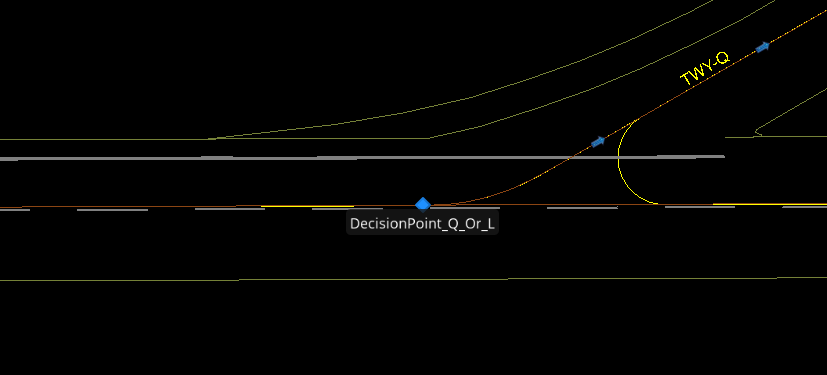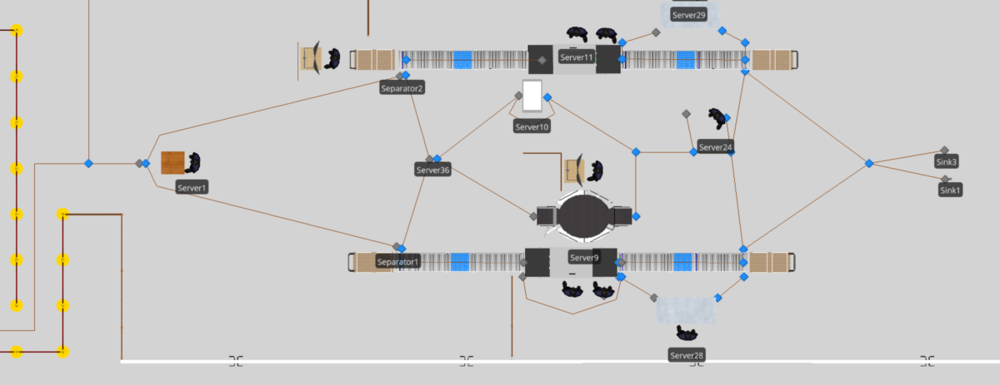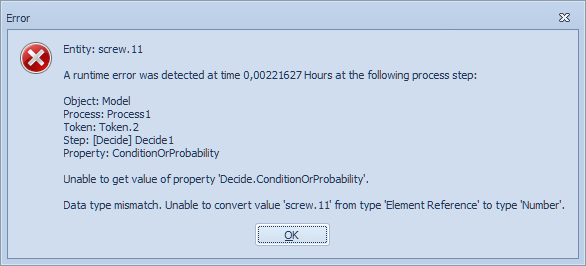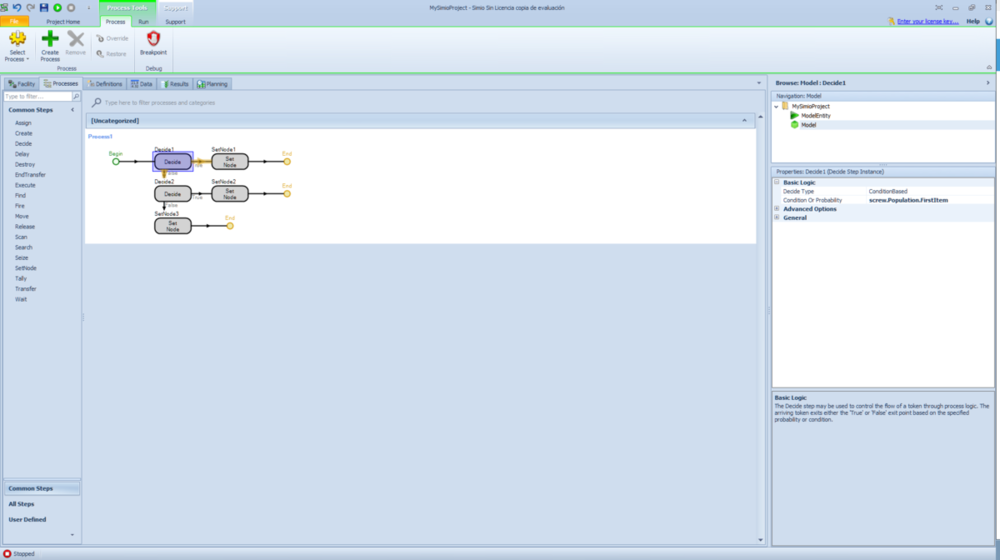Search the Community
Showing results for 'wait in transfer node'.
-
I have 2 transports delivering entities to 3 servers. What should be happening is that Transport 1 loads entities to capacity (12) then moves to Server 1 and delivers all of the entities (12). Transport 2 should load 12 entities and deliver all 12 to Server 2. Transport 1 returns to Home Node and loads 12 more entities for delivery to Server 3... and so on. However, what is happening is that both Transports are loading 12 entities then moving to Server 1 and delivering 4 entities each, then on to Server 2 and repeat and so on. I have removed and added servers to confirm that for some reason the Transports are delivering 1/#ofServers of their total capacity, conducting all of their deliveries and then returning to home once empty. I have limited the timepath to each Server to only allow 1 Transport at a time, but then Transport 2 just waits at the Home Node until Transport 1 is on its way to Server 2. Then it moves to Server 1 and just ends up one node behind Transport 1 at all times. The dispatch logic: (Server1.InputBuffer.Contents.NumberWaiting <= 12)||(Server2.InputBuffer.Contents.NumberWaiting <= 12)||(Server3.InputBuffer.Contents.NumberWaiting <= 12); set at Smallest Value for Selection Goal; Selects from a List of all Server Nodes.
-
A quick solution to force all entities to get dropped at the same place is to add an add-on-process when an entity is loaded. which Checks if the entity is the first item in the vehicle and if not set its destination node to the first item. Decide: Token.associatedobject==Token.ContextObject.Vehicle.RideStation.Contents.FirstItem If False -> SetNode: Token.ContextObject.Vehicle.RideStation.Contents.FirstItem.ModelEntity.destinationnode a more elegant solution would probably involve batching the entities into a bucket that would then get transported to the destination. Upload 11.1.21.spfx
-
Combine several entities in to one entity
gocken replied to BTECHStudent's topic in SI General Discussions
It seems the best way to achieve to what u want is to define three storage elements (called barstorage, gridstorage, sheetstorage) just before the combiner object or combiner node. Whenever an entity is put into any of these storages check the the condition u defined (i.e., exactly 4 bars, 4 grids and 8 sheets are exist in the individiual storage) is valid. If the condition is satisfied remove appropriate number entities (exactly 4 bars, 4 grids and 8 sheets) from appropriate storage by using search and remove step and transfer them to combiner object from standard library (or even combiner node object you get from forum) to combine them all. Else wait for the condition to be met. By this way you are able to collect some extra statistics from storages (averge waiting times and average number of each materials in the storage etc...). -
I can see average wait times but need to measure wait times over a threshold. I would think there would be an attribute of ModelEntity such as TimeInSystem or TimeNow. I can't tell how to measure from entering the queue to leaving the queue using standard library objects. Do I have to model this entirely with processes? Thanks.
-
As far as I understand I included my solution approach. You may wonder that the included logic does not seem work (it will always increases the capacity but wont decrease it). This may be due to your servers processing time or on/off shift schedules. I mean that in order to see how it works you should increase capacity by some predeterimed number (i.e., 10. Currently it is set to 1) and decrease it one each time any entity enters or departs waitingarea1 node. you may also increase run time to further see what happens. I hope this one meets your requirements. Still it will inspire you. NOTE: You should note that the unit time conversions and your problems' values. The logic triggers capacity increments or decrements each time an entity enters or departs from waitingarea1. Note also that waiting times are calculated as averages of those who wait at waitingarea1 transfer node throughout the simulation run. pharmacy_candidate solution.spfx
-
Hi I want to randomly send one entity to 3 diferent nodes, but each entity can only visit each node once. I.e., Entity 1 will travel 'Source -> NodeA -> NodeB ->NodeC -> Sink' and entity 2 will travel 'Source -> NodeB -> NodeA ->NodeC -> Sink' and so on. Right now I'm using Routing by sequence, but it only verifies the rule to visit every node but not randomly... So the last nodes from the list are becoming the bottleneck when they are not. I could also create individual sequence tables for each possibility, but in my model I Need around 1000 diferent routes so that's not a good Option. Any idea? Thanks!
-
Hi, I'm working on an airport simulation, this is my first simulation, i have a transfer node that has one income link and two output links, so I would like to know if there is a way that depending on certain Entinty's boolean state variable, whe passing throught the tranfer node if the state is true set and specific outbound link and if it is false then set the outbound link rule by link weight.
- 1 reply
-
- routing
- state variable
-
(and 1 more)
Tagged with:
-
Varying Path Length and Moving Servers
gocken replied to DavidMann's topic in SI General Discussions
You can place some enough transfer nodes at different distances and directions (In freespace it will be hard to stop modelentity object and seize the server object. This can be quite challenging task). Then you can randomly send the modelentities to one of these transfer nodes (This is for sending entities some vector away from the source). Then, define an entered add-on process trigger for each transfer nodes and place a move step onto this add-on process. In resource movement request of this step define object type specific (or from list), object name any server (or from list you set), and destination node as the transfer node itself. Then, you can try seize step to or transfer step to send the entity onto server object. You have to try some options. -
Hi, I would like to call for the ride, before an entity arrives at the node where it will be loaded. For example, if the entity is at node 1, I would like it to request the transport at that node. When the request is sent, The transport will start moving its way to node 2. Once the transport arrives at node 2, entity will start moving its way to node 2 and load to the transport. Thanks in advance
-
Hello, I have been utilizing SIMIO for a couple of months, however I am relatively unfamiliarized with some of the features. I have recently encountered a difficulty while simulating an airport screening checkpoint. Take the attached picture as a reference. I have entities arriving from a single Source, processed initially at Server 1, and then following a series of separators and additional servers along the way. At Separator 1, the member (luggage) is separated from the parent (passenger). (Luggage is created by a "create" step in an add on process, rather than at its own Source). However, I would like to distinguish statistics between those travelers and luggage going twice through a server. For example in Server 10, I have a loop going from the output node to the input node for the re-scanning of passengers. I managed to provide a priority value to the passengers going though that created loop, and an add on process rule to send those with that priority value to Sink 3, while those without the priority value to Sink 1. I tried applying the same concept to the loop seen in Server 9. However, when the passenger picks up the luggage at the transfer node located at end of the conveyor belt, both the member and the parent exit through Sink 1, rather than Sink 3. It appears that only the member obtains the priority, but not the parent. Although I tried, I did not manage to match the priorities and thus have the combined entities exit the model as anticipated. Any thoughts on how I could match the priorities, or perhaps, any suggestions to make this possible? Any help is greatly appreciated!
-
[EDIT] Hi all, I am modeling a restaurant, where orders are placed until 22:00. The preparation of these orders takes approximately 20 minutes (it can be more or less due to the probability distributions involved). I have some workers whose schedules are from 10:00 to 22:30 and they prepare these orders. The problem is the following. Suppose that it's 22:30 and there are still some orders in the queue. Since the worker's schedule ends now, those orders can't be processed and will remain for the next day. This obviously does not happen in a real-life restaurant. So if at the end of the worker schedule (22:30) there are some orders in queue, I would like to extend the schedule until all orders are met. The problem is I don't know how long it will take the workers to prepare the missing orders, so I can't suppose a certain time needed to complete the orders. I have to wait that the last order is prepared to set the end of the working day. How can this be done? Thank you in advance, Marcel Favereau
-
Yes, I need to create a material based on the entities' arriving (each entity has a BOM ) and the entities have to wait in the node untill the production of the material (leather). It seems that the model can't see the process and it doesn't produce the material and it doesn't respect the lead time. Maybe there is a problem with the tokens and the varaibles' assignments.
-
First, you should define a "NodeReferenceState" on ModelEntity. After finding the appropriate sink to send use "set node" step to assign the found sink's input node as the destination node of the entity (ModelEntity.NodeReferenceState=input@sinkx). Then, do not use transfer step. Instead, set the entity destination type property of source object as specific and also set node name property as ModelEntity.NodeReferenceState. By this way each entity will find its own way via the links you defined.
-
Hi Tom, thanks for your help! I've found a solution on my own in the meantime (probably not as sophisticated as yours but it works well). I additionally modelled a small version of the lift itself and created a wait process. The triggering event is "vehicle exits Node X". I used the process for my servers ("after processing"). So whenever a chair exits the node, the gates will open. This is actually quite close to reality where the gate opening interval is not fixed but depends on the speed of the lift and the point in time when an empty chair arrives. All the best, Nico
-
Hi, I am working on a transportation model where the vehicle drops off customers at a station and is parked at the node until it is further required. Is there a way to limit the number of vehicles a station can hold? Thanks, Amit Sinha
-
Is it possible to implement a wait step that either waits for a specified time, or for an event to be fired (which ever comes first). I hacked together a model where I execute a process before the wait step, that delays for the time and fires an event. I then simply listen for either event at the wait step. I don't think this is very neat. Is there a better way? I can see there are timer elements, but I don't see how you would invoke one simply to act as a countdown.
-
I appreciate your help as it solved the problem! However, I have one more question. When I apply the rule for only two separators there is no issue, but when I try to apply it to multiple separators a new challenge is encountered. Take the new picture as a reference. Instead of having one server being linked to two different separators, now I have multiple servers (Server 2-7) linked to a shared transfer node that is linked to multiple separators (Separator 3-8). If I apply the same rule, when all the separators are in the active position (value of 1), all the entities are prone to use separator 3 and 4 being that it is the closest to the transfer node. This occurrence generates an outstanding entity queue as none are being routed to separators 5 -8, even though they are active. Similarly, if I provide separator 3 and 4 with an off shift rule (value of 0), the entities are prone to use separator 5 and 6, and not take separator 7 and 8 to alleviate the queue. The question is: Is there a way to apply a routing logic in the transfer node that aside from taking the path to the active separator, also distributes the entities uniformly(or take the one with the shortest route)between all available (active) separators?
-
Sequence Table - Destination as 'Node list property'
mohmed Shaikh replied to mohmed Shaikh's topic in SI General Discussions
Many thanks CWatson. This worked. I was able to use 'Select from List' from the transfer node. -
Crane Library - Bridge and Underhung bridge cranes
Rylan Carney replied to dsturrock's topic in SI Shared Items
Hello ttarken, A simplified approach might be use a Resource to constrain the system until the required operator is available. If the operator should move with the Crane, a good starting point might be to try seizing a Worker and requesting a move to the pickup Node. Then, you could try using a Move step to move the Worker from the pickup Node to the drop-off Node with the Crane. Please see below a link to a similar post discussing how to use two Cranes to move a single entity. The example model attached to the other post might provide guidance for your application. -
Modeling multiple cranes on a common (shared) runway is hard to do well. Still harder when you take into account acceleration, crane blocking, and good 3D animation. If you have encountered this problem, here is a solution. For standard bridge crane movement, we recommend the simpler Crane object in the Extras library. But if you need the underhung cranes with cabs moving between bays, read on... The Simio Crane Library is a collection of objects designed for modeling multiple cranes operating simultaneously in a bay. The library is provided as an example of complex material handling using the standard features of Simio. The Crane library may be used in conjunction with the Simio Standard Library, and Crane pickups are done using the standard TransferNode (e.g. the output side of a Server). Crane drop-offs can be done at either a BasicNode or TransferNode. The Crane Library can also be used with custom libraries as long as they support rider pickups using the standard transporter ride features. The Crane Library consists of objects representing the Bay, Bridge, Cab, Lift, and Crane (the end effecter that actually picks up and drops off the item). These objects are combined together to model multiple cranes moving in a single bay. The separation of objects in this way allows you to use your own symbol for each component. A Crane movement occurs by first rising up from the pickup node to a specified travel height, traveling laterally at that height, and then lowering down to the specified drop-off node. All travel is done through free space without the need to explicitly draw a network. The Crane library also fully supports independent acceleration/deceleration and the ability for one crane to cause another blocking crane to move out of the way. The above library file is now obsolete. Instead, download the library posted closest to the bottom topics. Like all Simio-provided libraries, this library is open so you can look at how it was built, learn from it, and subclass your own objects to improve them. But unlike our built-in libraries, this is not fully supported (although we can provide some help) and we may not continue enhancing it, particularly if we decide to build this capability into the base Simio products. We are anxious to receive your feedback on this library.
-
Blocking a server through a waiting room
gocken replied to Sebastian Vicencio's topic in SI General Discussions
Since I am not allowed to save my changes on your file directlt I am not able to upload your revised model. But, it is so simple to follow the steps to get what you wnat. First delete all your processes in your model and only for Volvo server define an afterprocessing add-on where you should include a decide step, an assign step and a wait step (see the attached file). Then, 1) set decide type as conditional and set its condition as: (M1.Capacity.Remaining > 0 && Input@M1.NumberTravelers.RoutingIn == 0) && (M2.Capacity.Remaining > 0 && Input@M2.NumberTravelers.RoutingIn == 0) && (T4.Capacity.Remaining > 0 && Input@T4.NumberTravelers.RoutingIn == 0) 2) at assign step set state variable as: Volvo.ResourceState and set the new value as: 2 (setting this to 2 will block the volvo server) 3) at wait step set event name as Output@T4.Entered. I hope this works for you. -
Hello, I specified a simple sequence of destinations for an entity with a sequence table and I would like to change the symbol of a subclass server depending on the current node destination of this sequence. I tried to make a process with a decide step but I can not find the good expression to get the current node destination. I am new with Simio so I wonder if it is a good way to proceed or if there is a better one? Best regards,
-
First Entity Id created should be Entity.1
simiouser1 replied to simiouser1's topic in SI General Discussions
Maybe my application is easier. I would like to create a batch of 150 entities, but only the first and the last should go to a different server than other 148. To do that, I have created a transfer node and I created a procces with to decide node, asking if the entity is the first or the last. But it does not work. -
Multiple Entity with multiple sequence tables
USP2010 replied to JanainaF's topic in SI General Discussions
To Whom It May Concern, I also have a very similar issue with multiple entities and multiple paths (for some entities). Could I also have the solution shared in this forum? I have tried multiple sources, transfer nodes, and sequence tables. I just seem to be running into different errors trying to achieve the same goal. Thank you, in advance, for your assistance!










